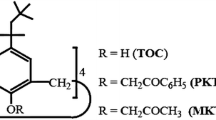Abstract
The synergistic extraction behavior of PdII, one of the main radioactive fission products in the reprocessing process, from HNO3 solutions with a 4-aroyl derivative of 1-phenyl-3-methyl-pyrazolone-5-one (PMP), a weakly acidic chelating extractant 1-phenyl-3-methyl-4-(2-methoxybenzoyl)-pyrazolone-5-one (HPMMBP), and a trialkylamine of high molecular weight, tri-iso-octylamine (TiOA), has been studied. An obviously antagonistic extraction effect was observed in the extraction system under the given conditions. To understand this phenomenon, a preliminary investigation was performed to explain the mechanism of this reaction. According to the theory of the corresponding solutions (TCS), the association between HPMMBP and TiOA is presented and discussed in the organic phase. An associated species HPMMBP·TiOA formed through hydrogen bonding in a CHCl3 medium might be the main reason why an antagonistic extraction effect occurred. The association constant between HPMMBP and TiOA was calculated to be 0.212 ± 0.03
Similar content being viewed by others
References
G. Uchiyama, S. Fujine, S. Hotoku and M. Maeda, Nucl. Technol., 102, 341 (1993).
R.J. Taylor, I. May, V.S. Koltunov, S.M. Baranov, V.I. Marchenko, E.A. Mezhov, V.G. Pastuschak, G.I. Zhuravleva and O.A. Savilova, Radiochimi. Acta, 81, 149 (1998).
G. Uchiyama, H. Mineo, T. Asakura, S. Hotoku, M. Iizuka, S. Fujisaki, H. Isogai, Y. Itoh, M. Sato and N. Hosoya, The 3th Int. Conference of NUCEF 2001, Japan Atomic Energy Research Institute, JAERI-Conf 2002-004, 197, 2002.
V.S. Koltunov and S.M. Baranov, Proc. of the Int. Conf. on Evaluation of Emerging Nuclear Fuel Cycle Systems, Global '95, Versailles, France, 577, 1995.
A. Zhang, J. Hu, X. Zhang and F. Wang, Solvent Extr. Ion Exch., 19, 965 (2001).
A. Zhang, J. Hu, X. Zhang and F. Wang, J. Radioanal. Nucl. Chem., 253, 101 (2002).
Z. Kolarik, U. Müllich and F. Gassner, Solvent Extr. Ion Exch., 17, 1155 (1999).
E.P. Horwitz and D.G. Kalina, Solvent Extr. Ion Exch., 2, 179 (1984).
Y. Morita, T. Fujiwara and K. Shirahashi, Proc. of the Int. Conf. on Evaluation of Emerging Nuclear Fuel Cycle Systems; Global '95, Versailles, France, 1163, 1995.
C. Madic, P. Blanc, N. Condamines, P. Baron, B. Berthon, C. Nicol, C. Pozo, M. Lecomte, Proc. of 4th Int. Conf. on Nuclear Fuel Reprocessing and Waste Management; RECOD'94, 3, 24, 1994.
M.S. Murali and J.N. Mathur, Solvent Extr. Ion Exch., 19, 61 (2001).
S. Tachimori, Y. Sasaki and S. Suzuki, Solvent Extr. Ion Exch., 20, 687 (2002).
W.W. Schulz and E.P. Horwitz, Sep. Sci. Technol., 23, 1191 (1988).
A. Zhang, Y. Wei and M. Kumagai, Solvent Extr. Ion Exch., 21, 591 (2003).
Y. Wei, A. Zhang, M. Kumagai, M. Watanabe and N. Hayashi, J. Nucl. Sci. Technol., 41(3), 1 (2004).
E.P. Horwitz, M.L. Dietz and D.E. Fisher, Solvent Extr. Ion Exch., 9, 1 (1991).
A. Zhang, Y. Wei, M. Kumagai, Y. Koma and T. Koyama, Radiat. Phys. Chem., 72, (2004). in press.
E.P. Horwitz, R. Chiarizia and M.L. Dietz, React. and Funct. Polymers, 33, 25 (1997).
E.C.O. Kafor and B.A. Uzoukwu, Radiochim. Acta, 51, 167 (1990).
A. Zhang and Z. Yang, Chinese J. Process Eng., 1, 272 (2001).
M.L.P. Reddy, S.K. Sahu and V. Chakravortty, Solvent Extr. Ion Exch., 18, 1135 (2000).
A. Zhang, B. Qian and G. Gao, Chinese J. Appl. Chem., 13, 90 (1996).
X. Li, H. Wanyan and R. Yang, Polyhedron, 9, 2285 (1990).
J.P. Brunette, M. Taheri, G.G. Grandmont and M.J.F. Leroy, Polyhedron, 1, 457 (1982).
S.S. Yun, H.B. Yang and H.S. Park, Polyhedron, 4, 1865 (1985).
J.P. Brunette, M. Lakkis, G.G. Grandmont and M.J.F. Leroy, Polyhedron, 1, 461 (1982).
A. Zhang, B. Qian and H. He, Chemistry, 9, 42 (1996).
M.Y. Mirza and R.T. Bailey, Inorg. Nucl. Chem., 41, 772 (1979). TMCH 5884 576
Author information
Authors and Affiliations
Rights and permissions
About this article
Cite this article
Zhang, A., Wanyan, G. & Kumagai, M. Extraction Chemistry of Palladium(II). Mechanism of Antagonistic Synergistic Extraction of Palladium By A 4-Aroyl Derivative of 1-phenyl-3-Methyl-Pyrazolone-5- one and Trialkylamine of High Molecular Weight. Transition Metal Chemistry 29, 571–576 (2004). https://doi.org/10.1023/B:TMCH.0000037532.41519.61
Issue Date:
DOI: https://doi.org/10.1023/B:TMCH.0000037532.41519.61




